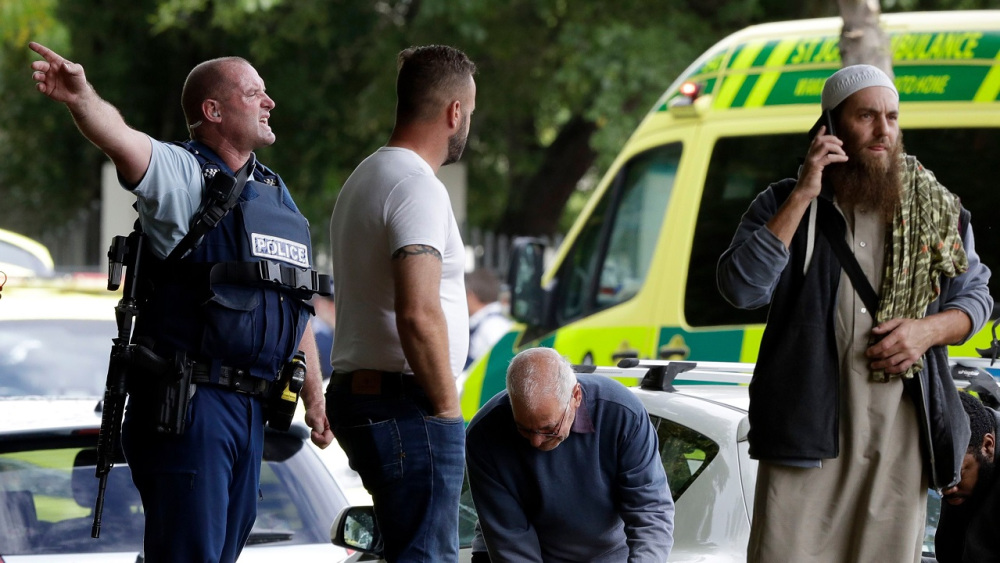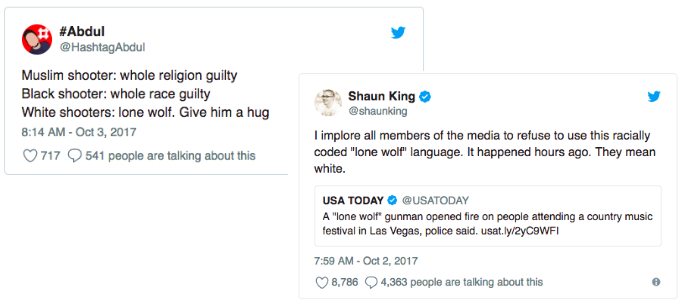Can White Shooters Be Terrorists?
Comparing coverage of the Christchurch massacre to US mass shootings

On Friday, March 15 a man identified as Brenton Harrison Tarrant walked into two mosques in Christchurch, New Zealand and perpetrated the largest mass shooting in the country’s history, killing 49 people. In the hours that followed, details emerged about a manifesto that Tarrant had written, in which he explicitly states that the attacks were motivated by white supremacist, anti-immigrant ideology.
Over the course of the next day, a social media frenzy broke out as politicians, celebrities and ordinary citizens took to Twitter, Facebook and other platforms to express their sorrow and outrage. Some users, including actor-director George Takei, scorned the media for failing to label Tarrant a terrorist, implying this stems from racial bias.

Interestingly, this narrative is not a new one: Takei’s criticism echoes those made in the aftermath of the 2017 Las Vegas shooting, in which another white man, Stephen Paddock, killed 58 people. Take, for example, these two tweets:

Journalists and public figures asserted that the media intentionally avoided calling Paddock a terrorist because he was white. Instead, they tended to refer to him as a lone wolf, or speculated about his mental health. Muslim or black shooters, critics argued, would not have been afforded the same sympathetic treatment.
Is it true that the media are more likely to associate Muslim shooters than white shooters with terrorism? Is this the case even when shooters are clearly motivated by ideologies of white supremacy or Islamophobia?
To answer this question, I use computer-assisted methods to analyze 11,495 articles that discuss mass shootings published between 1999-2018 in The New York Times, The Washington Post and The Wall Street Journal. I focus on newspaper coverage of US shootings with seven or more casualties, of which there have been 24 during this time frame. I identify perpetrators by race and religion, and calculate the prevalence of words like “terrorism” and “extremism” in articles about white shooters versus those about Muslim shooters.
It turns out that the words “terrorism” and “terrorist” are much more likely to appear in articles about the four Muslim shooters than in those about the seventeen white shooters in my dataset. 57% of articles mentioning Muslims compared to only 14% of articles related to whites contain these words. More tellingly, they appear in only 26% of articles discussing ideologically motivated white shooters, who are individuals openly affiliated with white-supremacist or alt-right ideologies. Similarly, words like “extremist,” “radicalism,” “militant,” and “fanaticism,” appeared in 41% of articles about Muslim perpetrators, in only 13% of articles about white perpetrators, and in 26% of articles mentioning ideologically motivated white shooters.
This seems to confirm Takei’s suspicions that the media treats white perpetrators differently, and suggests that Tarrant would not be commonly labeled a terrorist by the news media. That said, there is a high probability that the media will designate him a “white nationalist,” “white supremacist,” “neo-nazi,” or as “anti-immigrant” instead. Words like these were employed in 46% of articles about ideologically motivated white shooters, a category that clearly applies to Tarrant.
Surprisingly, the words “terrorism” and “terrorist” are surfacing more frequently in articles published about the Christchurch attacks than in stories about previous ideologically motivated shooters. Reporters from The New York Times, Washington Post, The Guardian, Rolling Stone and CNN have labeled Tarrant a terrorist without reservation. This is strikingly different from media coverage of white supremacist Dylann Roof’s 2015 shooting at Emanuel African Methodist Episcopal Church in Charleston, or even Robert Bowers’ shooting at the Tree of Life Synagogue in Pittsburgh. When “terrorism” was discussed in articles about Roof and Bowers, it was posited more as a possibility than a fact.
Obviously, in the weeks and months ahead, more articles and a clearer media narrative about the Christchurch massacres will emerge. The words and framing that the media uses to represent this event matter; they can have significant consequences for societal and political discourse. As Michelle Ruiz explains in a Vogue article, labeling something an act of terrorism versus the act of an unstable, aberrant individual “often signal[s] the [political] action - or inaction - to follow. When ‘radical Islamic terrorists’ attack Americans, we wage war against them.” Media failure to call white nationalist violence terrorism risks underestimating its inherent threat, and may inhibit effective policy-making to counteract it.
So far, newspapers’ unexpected willingness to label the Christchurch attacks terrorism – and Tarrant a terrorist – suggests two possibilities. We may be seeing a shift in media framing, through which criticisms like Takei’s are influencing journalists and the words they use to describe ideologically motivated white shooters. On the other hand, it is more likely that the words used are a function of the New Zealand Prime Minister’s decision to publicly designate the shooting terrorism, in stark contrast to President Trump’s refusal to do so regarding the Tree of Life Synagogue shooting. If this is the case, Christchurch may be more of an exception to the rule than a harbinger of change in US media coverage of mass shootings.
-Emily Stabler
Methodological note: I analyzed 11,495 articles drawn from The New York Times, The Washington Post and The Wall Street Journal. My analysis includes every article published in those papers between January 1st, 1999 and November 30, 2018 with the root words “mass shooting!”, “mass shooter!”, “shooting rampage!”, “rampage shooting!”, “mass rampage!”, “rampage shooter!”, “school shooting!”, “school shooter!”, “shooting spree” or “gun spree” in the headline or text of the article. For additional information about our methods, see here. Photo credit: Mark Baker/AP/Rex/Shutterstock